|
From paddle steamers to
superferries
Early 19th century paddle-steamers were a big advance!
They appeared in an age when travel was slow, expensive and
often dangerous. Most people lived and died within a few
miles of where they were born - except for occasional
journeys to their local market town. Only the rich could
take holidays: in past centuries, when ordinary people
travelled abroad, it was as soldiers, sailors, or
pilgrims.
|
|
Crossing the channel by
sailing ship
Crossing the channel by sailing ship was at the mercy
of tides and weather. Until the late 19th century, landing
was often a problem - harbours on both sides were rather
shallow and not well protected against storms.
Ships often had to wait offshore at Dover or Calais until
the tide was high enough to enter the harbour - or else
cross to the beach in a small rowing boat.
Travel to the coast was equally perilous. On an 18th
century horse-drawn stagecoach, you could travel from Paris
to Calais or Dover to London within a long, dusty day -
highwaymen and the state of the roads permitting.
|
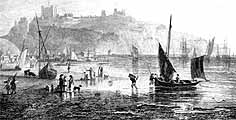
If your ferry could not enter the harbour, hard-faced local
boatmen in Dover (and Calais) charged more to row you ashore
with your luggage than you paid to cross the
Channel!
|
|
Steamships
In 1820 the French government bought a pioneer
Glasgow-built paddle-steamer, the "Rob Roy", to carry the
mails from Calais to Dover. It proved fast and reliable in
the open sea, and in 1822, a Dover company used two paddle
steamers to carry the English Post Office's mail and
passengers across the channel. All were tiny boats by the
standard of today's ferries - with wooden hulls, 30-odd hp
engines, about 100tons, 15ft wide, 80+ft long. Being small,
the ships tossed about in waves; seasick passengers
travelled on deck with little shelter
Railway rivalries:
Boulogne vs Calais
In the 1840s the building of long distance railways
brought more passengers to the channel ports. Boulogne began
a long rivalry with Calais to develop the ferry trade.
The South Eastern Railway company developed
Boulogne-Folkestone route as an alternative to Calais-Dover,
because of difficulties with Dover harbour. They were able
to buy and improve the neighbouring port of Folkestone, from
where they operated a fleet of steamships with connecting
train-ship-train services between London and Paris, aimed at
wealthy travellers.
|
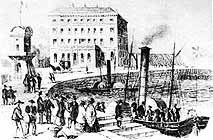
Dover Harbour: when the London-Dover railway opened
in 1844, the railway company built a grand hotel for posh
travellers to wait in comfort for the next paddle
steamer.
|
|
19th century progress:
better ships
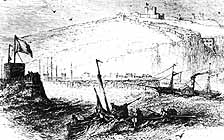 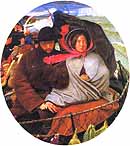 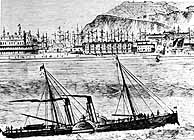
1.
Dover Harbour:
ferries still had to wait for high tide to come in and out,
so could not keep to regular timetables. Navigating the
entrance was tricky in rough seas.
2.
"The Last of
England" (painting by Ford Maddox Brown 1852-5):
Travellers dreaded a rough passage, with seasickness and
fear of shipwreck.
3. In the1850s most ships
were still powered by sail - paddle steamers also kept masts
and sails in case the engine broke down. Small steam ferries
could make a fast crossing whatever the wind direction - but
were tossed around on the waves.
|
|
19th century progress:
better harbours
During the second half of the 19th century, better
deep-water harbours began to be built on both sides of the
channel.
The Admiralty Pier was Dover's first deep-water berth.
From 1850, ferries could land their passengers at any state
of the tide, without having to pass the shallow inner
harbour entrance - a revolution!
|
|
A Naval harbour at
Dover
In 1895 after decades of deliberation, the Admiralty decided
it would be useful to build a large deep-water anchorage and
naval base at Dover, to help defence of the South east
coast. By the time the new harbour was completed in 1909,
torpedoes and longer range guns had been developed; Dover
was considered too vulnerable and too near the Continent to
risk basing the expensive Grand Fleet of massive new
"Dreadnought" battleships there.
The hugely expensive outer harbour became a "free gift"
to the ferry companies, at the Navy's expense.
|
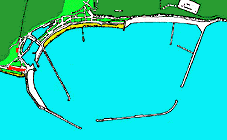
A huge naval harbour - and "harbour of refuge" was built for
the Navy at Dover before the First World War
|
|
First car
ferries
The traditional cross-channel traveller had always been a
foot passenger, arriving at the port by first horse-drawn
stage-coach, then steam-train - and embarking on the ferry
with all their luggage.
With the growing popularity of motoring, Captain Townsend
bought and converted an old minesweeper to cater for the new
market of people who wanted to take their car with them on a
Continental motoring holiday . Like other cross-channel
travel, most of the demand was from the UK side.
Cars were loaded onto the Dover-Calais car ferry by
crane: 6,000 in the first year, rising to 31,000 in 1939
before the Second World War interupted services.
After the war, new "drive on" ferry terminals were built
in Dover and Calais. Opened in 1953,they had moveable
loading bridges, so cars could drive on whatever the state
of the tide.
|
|
|
Train
Ferry
In 1936, the Southern Railway company and the new SNCF
invested in new train ferry docks at Dover and Dunkerque.
These ships had rails on the cargo deck to carry railway
carriages and wagons. At each end, the ship ran into a dock
where the water level could be adjusted so that the trains
could run off the ship onto the tracks. The luxury "Night
Ferry" train had through coaches between London and Paris on
this route, whilst the famous daytime "Golden Arrow" used
the Dover-calais route, with separate trains either side of
the channel - its rich passengers had a brief walk on and
off the SS Canterbury (later SS Invicta), which was
specially furnished for their benefit *.
* Thanks to John A
Stedman
|
|
Hovercraft
In 1959, a one-man hovercraft successfully crossed the
channel, landing on the beach inside Dover harbour. This
experimental British invention promised to revolutionise
cross-channel travel - offering a speedy crossing without
the huge initial investment in building a tunnel which would
be required for high-speed trains.
The craft were successfully scaled up so they could carry
hundreds of passengers and cars - though they could not cope
with rough weather. "Hoverpads" were built at Calais,
Boulogne, Pegwell Bay near Ramsgate, and in Dover harbour.
British Rail, SNCF, and Hoverspeed a private company all
competed to develop the new craft.
Unfortunately, they were made less economic by the rise
in fuel prices in the 1970's, because they used fuel heavily
just to stay up as well as to move. The last services were
withdrawn in 2000.
|
|






